1993 CHEVROLET LUMINA towing
[x] Cancel search: towingPage 56 of 324
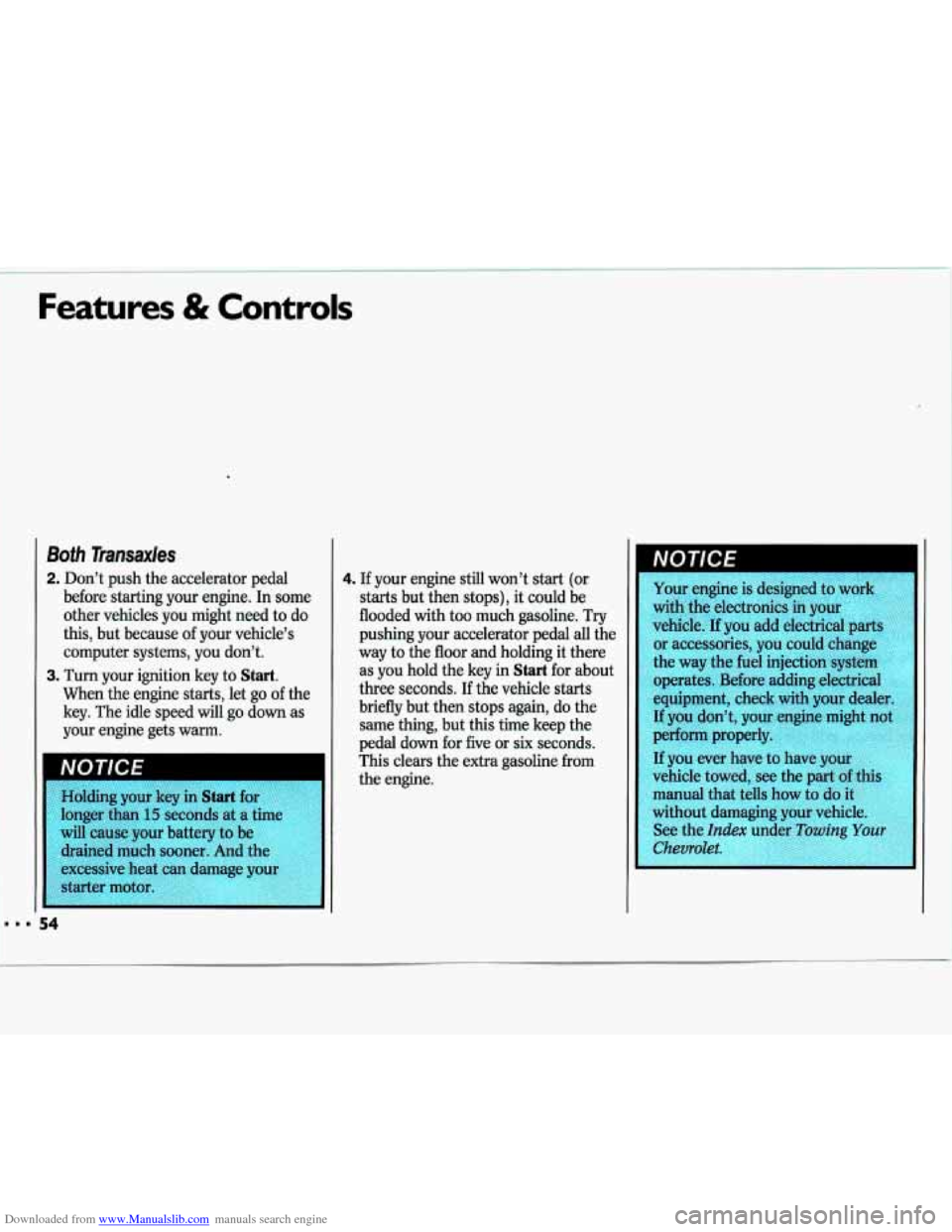
Downloaded from www.Manualslib.com manuals search engine Features & Controls
Both Transaxles
2. Don’t push the accelerator pedal
before starting your engine. In some
other vehicles you might need to do
this, but because of your vehicle’s
computer systems, you don’t.
3. Turn your ignition key to Start.
When the engine starts, let go of the
key. The idle speed will go down as
your engine gets warm.
%olding your key in
Start for
longer than
15 seconds at a time
will cause your battery
to be
drained much sooner. And the
excessive heat can damage your
starter motor.
54
4. If your engine still won’t start (or
starts. but then stops), it could be
flooded with too much gasoline.
Try
pushing your accelerator pedal all the
way to the floor and holding it there
as you hold the key in
Start for about
three seconds. If the vehicle starts
briefly but then stops again, do the
same thing, but this time keep the
pedal down for five or
six seconds.
This clears the extra gasoline from
the engine.
I
Your engine is designed to work
with the electronics in your
I
vehicle. If you add electrical parts
or accessories, you could change
the way the fuel injection system
operates. Before adding electrical
equipment, check with your dealer.
If you don’t, your engine might not
perform properly.
If you ever have to have your
vehicle towed, see the part of this
manual that tells how to do it
without damaging your vehicle.
See the
Index under Towing Your
Chevrolet.
Page 59 of 324
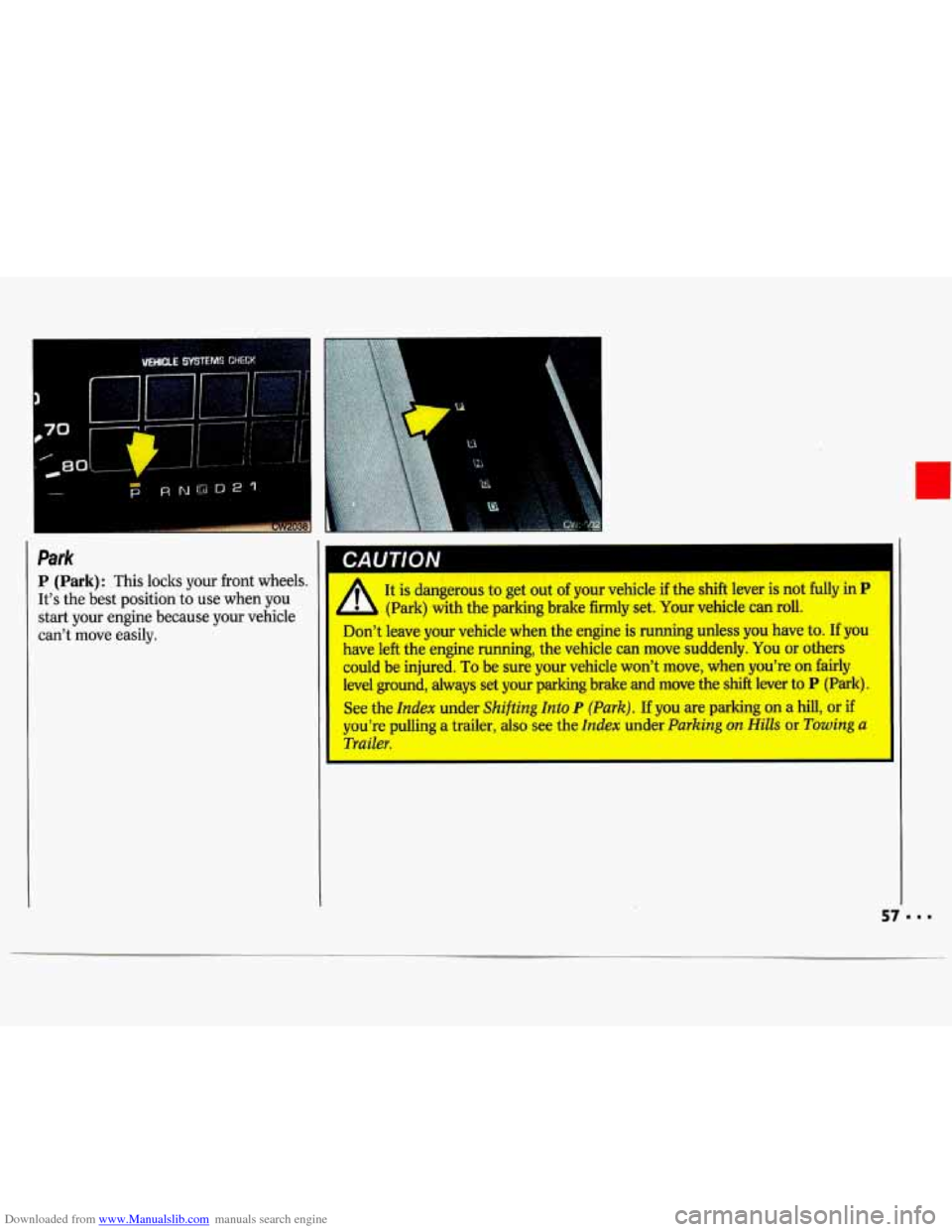
Downloaded from www.Manualslib.com manuals search engine Park
P (Park): This locks your front wheels.
It's the best position
to use when you
start your engine because your vehicle
can't move easily.
CAUTION
A
It is dangerous to get out of your vehicle if the shift lever is not fully in P
(Park) with the parking brake firmly set. Your vehicle can roll.
Don't leave your vehicle when the engine is running unless you have to. If you
have left the engine running, the vehicle can move suddenly.
You or others
could be injured.
To be sure your vehicle won't move, when you're on fairly
level ground, always set your parking brake and move the
shift lever to P (Park).
See the
Index under Shifting Into P (Park). If you are parking on a hill, or if
you're pulling a trailer, also see the
Index under Parking on Hills or Towing a
Trailer.
Page 62 of 324
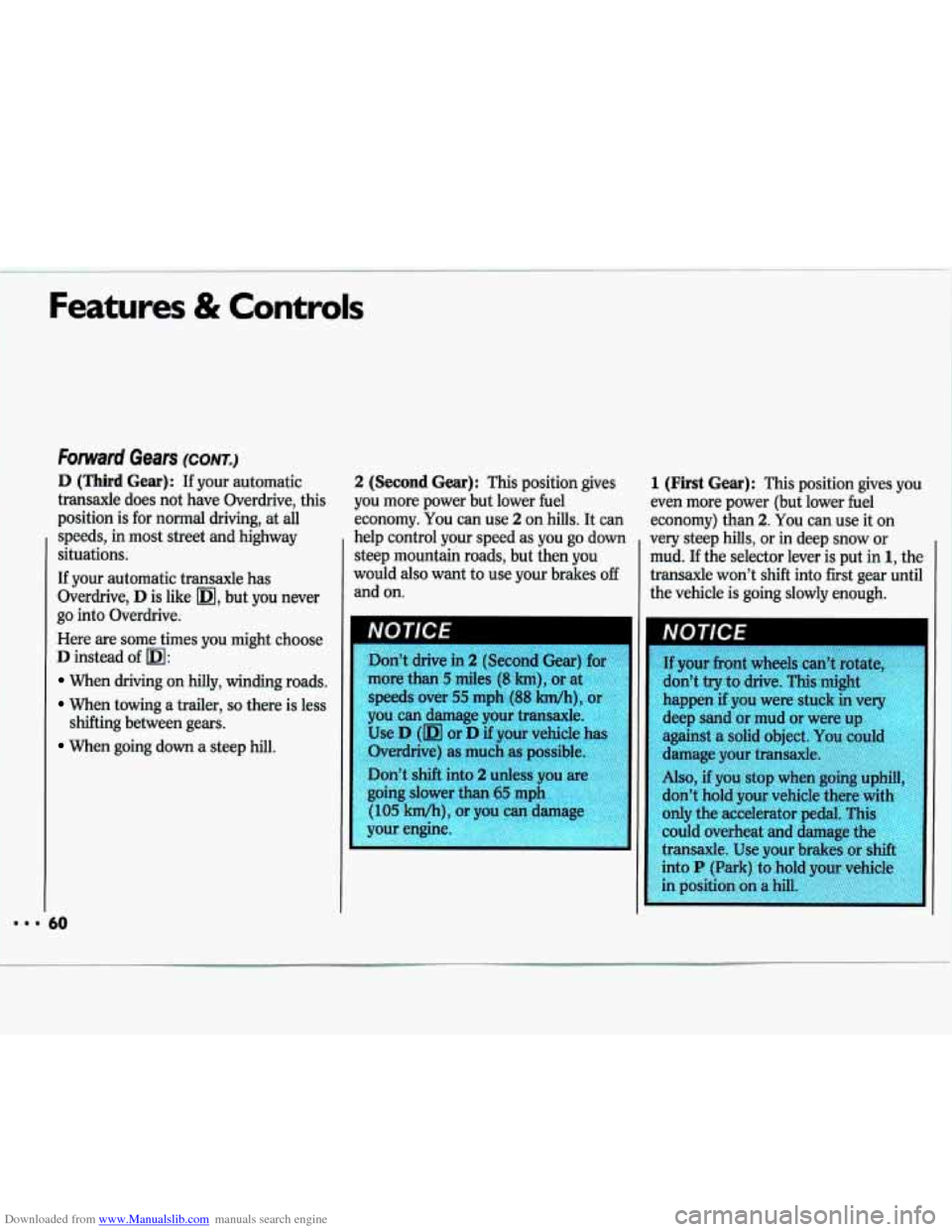
Downloaded from www.Manualslib.com manuals search engine ...
Features & Controls
Forward Gears (CONT.)
D (Third Gear): If your automatic
transaxle does not have Overdrive, this
position is for normal driving, at
all
speeds, in most street and highway
situations.
If your automatic transaxle has
Overdrive,
D is like m, but you never
go into Overdrive.
Here are some times
you might choose
D instead of m:
When driving on hilly, winding roads.
When towing a trailer, so there is less
When going down a steep hill.
shifting between gears.
50
2 (Second Gear): This position
gives
you more power but lower fuel
economy.
You can use 2 on hills. It can
help control your speed
as you go down
steep mountain roads, but then
you
would also want to use your brakes off
and on.
Don’t drive in
2 (Second Gear) for
more than
5 miles (8 km), or at
speeds over
55 mph (88 Mh), or
you can damage your transaxle.
Use
D (m or D if your vehicle has
Overdrive) as much as possible.
Don’t shift into
2 unless you are
going slower than
65 mph
(105 kwh), or you can damage
your engine.
1 (First Gear): This position gives you
even more power (but lower fuel
economy) than
2. You can use it on
very steep hills, or in deep snow
or
mud. If the selector lever is put in 1, the
transaxle won’t shift into first gear until
the vehicle is going slowly enough.
Page 66 of 324
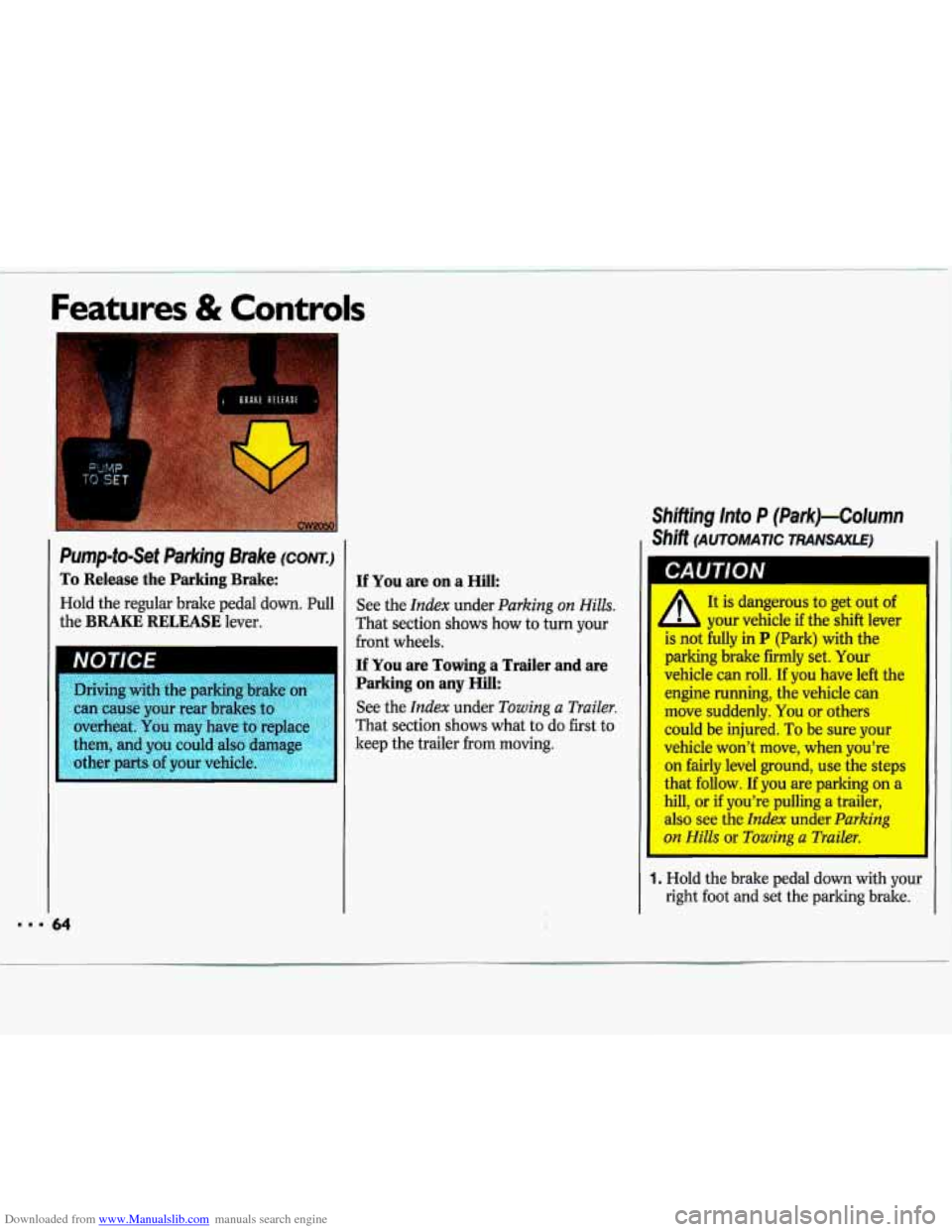
Downloaded from www.Manualslib.com manuals search engine - I
Features & Controls
Pump-to-Set Parking Brake (CONK)
To Release the Parking Brake:
Hold the regular brake pedal down. Pull
the
BRAKE RELEASE lever.
NOTICE
them, and you could also damage
If You are on a Hill:
See the Index under Parking on Hilh.
That section shows how to turn your
front wheels.
If You are Towing a Trailer and are
Parking on any
Hill:
See the Index under Towing a Trailer.
That section shows what to do first to
keep the trailer from moving.
Shifting lnto P (Park)-Column
Shift (AUTOMATIC TRANSAXLE)
UI
P
It is dangerous to get out of
b your vehicle if the shift lever
is not fully in
P (Park) with the
parking brake firmly set. Your
vehicle can roll. If you have left the
engine running, the vehicle can
move suddenly.
You or others
could be injured.
To be sure your
vehicle won’t move, when you’re
on fairly level ground, use the steps
that follow. If you are parking on a
hill, or
if you’re pulling a trailer,
also see the
Index under Parking
on . !Is or Towing a Trailer.
1. Hold the brake pedal down with your
right foot and set the parking brake.
Page 67 of 324
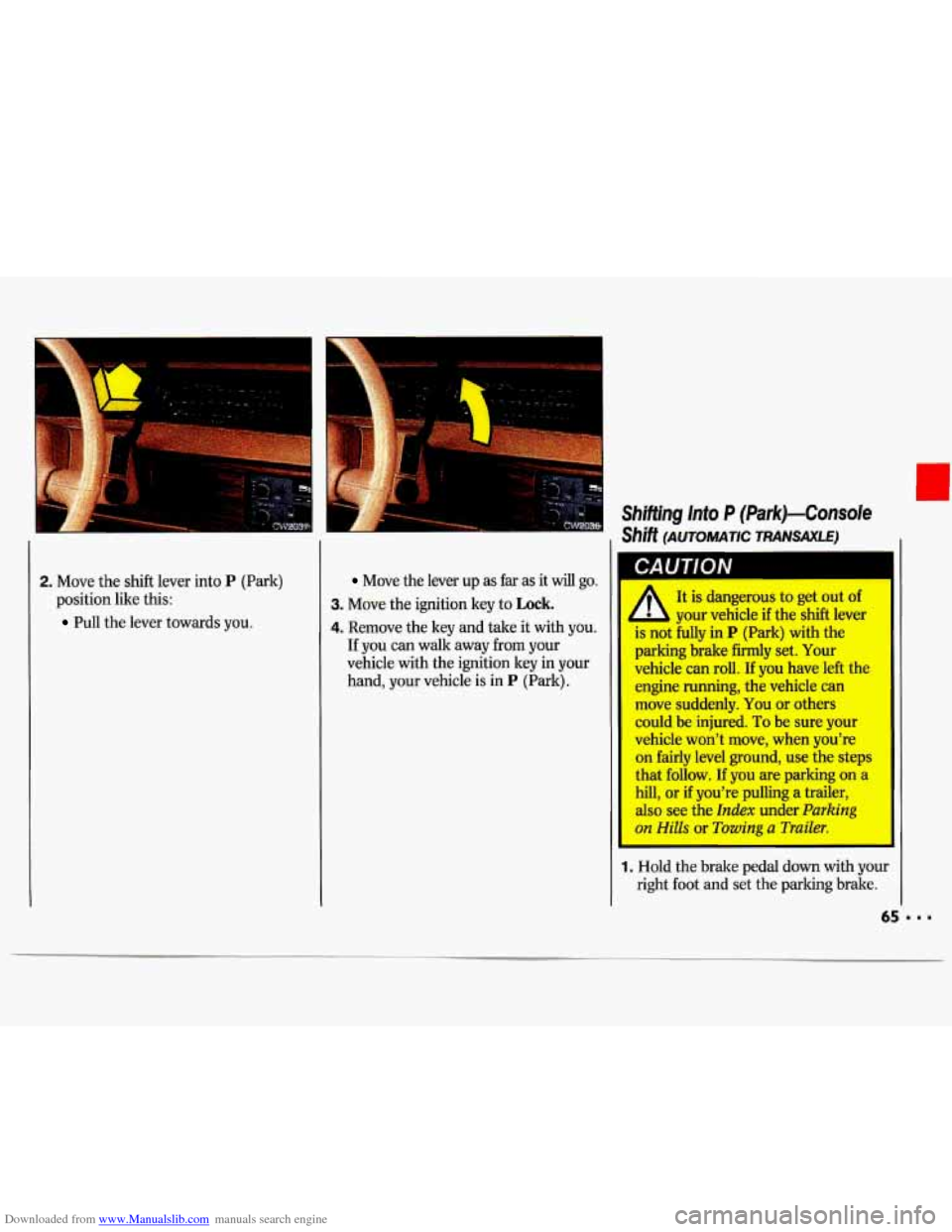
Downloaded from www.Manualslib.com manuals search engine 2. Move the shift lever into P (Park)
position like this:
Pull the lever towards you.
Move the lever up as far as it will go.
3. Move the ignition key to Lock.
4. Remove the key and take it with you.
If you can walk away from your
vehicle with the ignition key in your
hand, your vehicle
is in P (Park).
Shifting Into P (Park)-Console
Shift (AUTOMATIC TRANSAXLE)
A
1s not hlly in P (Park) with the
parking brake firmly set, Your
vehicle can roll. If you have left the
engine nmning, the vehicle can
mm suddenly. You or others
could be injured. To be sure your
vehicle won’t move, when yodre
on fairly level ground, use the steps
that follow. If you are parking on a
hill, or if you’re pulling a trailer,
also see the Index under Parking
on Hih ~r Towing a Trailer.
A It is dangerous to get out of
L your ve~e the shift lever I
1. Hold the brake pedal down with your
right foot and set the parking brake.
Page 95 of 324
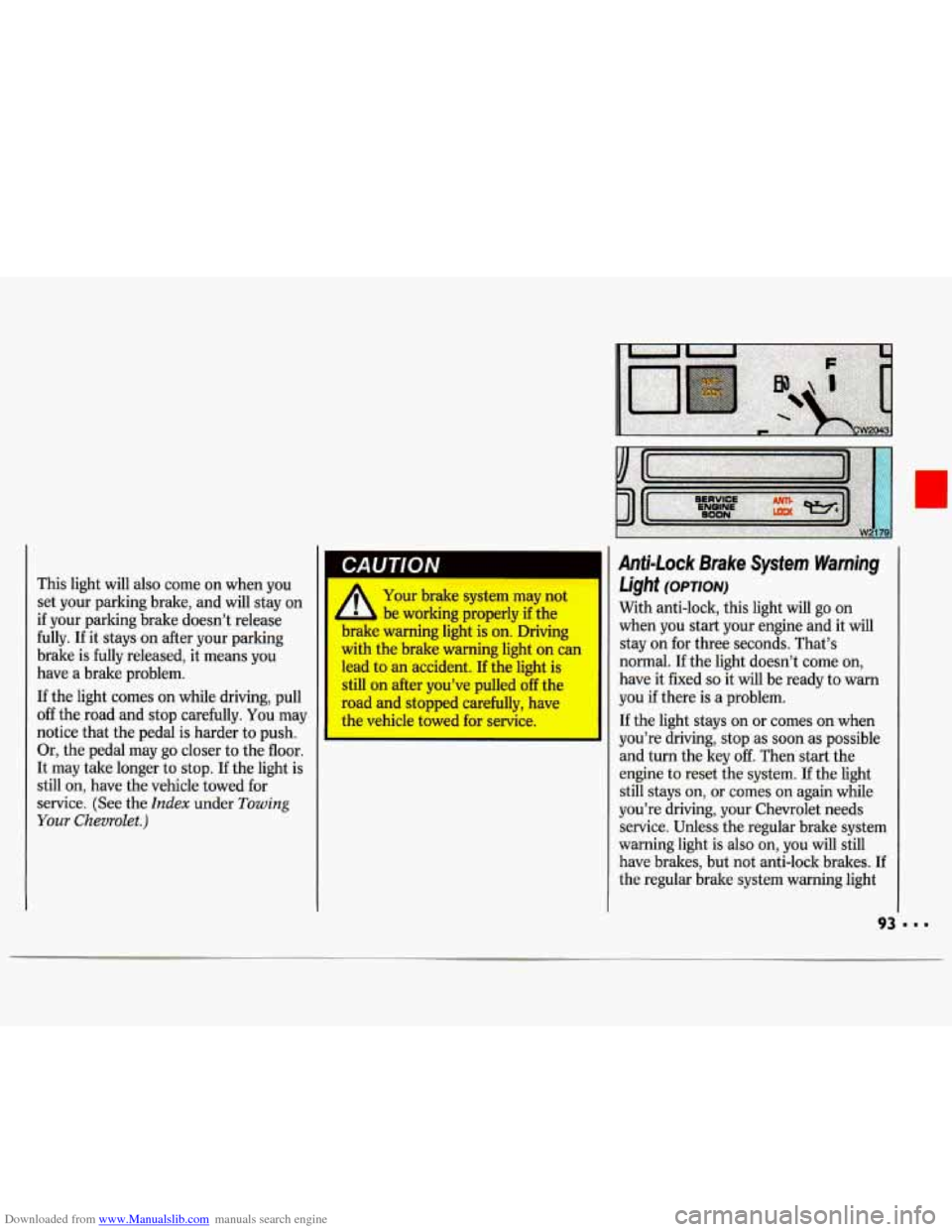
Downloaded from www.Manualslib.com manuals search engine This light will also come on when you
set your parking brake, and
will stay on
if your parking brake doesn’t release
fully. If it stays on after your parking
brake is fully released, it means you
have a brake problem.
If the light comes on while driving, pull
off the road and stop carefully. You may
notice that the pedal is harder to push.
Or, the pedal may go closer to the floor.
It may take longer to stop.
If the light is
still on, have the vehicle towed for
service. (See the
Index under Towing
Your Chevrolet.)
-
gu1/QIv ,1
A Your brake system may not ’ ‘ be working properly if the
LJlimt; warning light is on. Driving
with the brake warning light on can
lead to an accident. If the light is
still on after you’ve pulled off the
road and stopped carefully, have
the vehicle towed for service.
I I
Anti-Lock Brake System Warning
Light
(OPTION)
With anti-lock, this light will go on
when you start your engine and it will
stay on for three seconds. That’s
normal.
If the light doesn’t come on,
have it fixed
so it will be ready to warn
you
if there is a problem.
If the light stays on or comes on when
you’re driving, stop as soon
as possible
and turn the key
off. Then start the
engine to reset the system. If the light
still stays on, or comes
on again while
you’re driving, your Chevrolet needs service. Unless the regular brake system
warning light is also on, you will still
have brakes, but not anti-lock brakes. If
the regular brake system warning light
Page 119 of 324

Downloaded from www.Manualslib.com manuals search engine Part 4
Here you’ll find information about
driving on different kinds
of roads
and in varying weather conditions
.
We’ve also included many other useful tips on driving
.
Your Driving and the Road
Road Signs ........................................................................\
................................... 118
Drunken Driving ........................................................................\
......................... 123
Control of a Vehicle
Braking
........................................................................\
..................................... 126
Anti-Lock Brakes ........................................................................\
..................... 127
Steering Tips ........................................................................\
............................. 132
Steering in Emergencies ........................................................................\
.......... 133
Passing ........................................................................\
..................................... 134
Driving at Night ........................................................................\
........................... 137
Driving in the Rain ........................................................................\
...................... 139
Driving in Fog, Mist and Haze ........................................................................\
... 142
City Driving ........................................................................\
.................................. 143
Freeway Driving ........................................................................\
.......................... 144
Driving a Long Distance ........................................................................\
............. 146
Hill and Mountain Roads ........................................................................\
........... 148
Parking on Hills ........................................................................\
.......................... 149
Winter Driving ........................................................................\
............................ 151
Towing a Trailer ........................................................................\
........................... 154
Defensive Driving ........................................................................\
........................ 122
I I7
Page 156 of 324
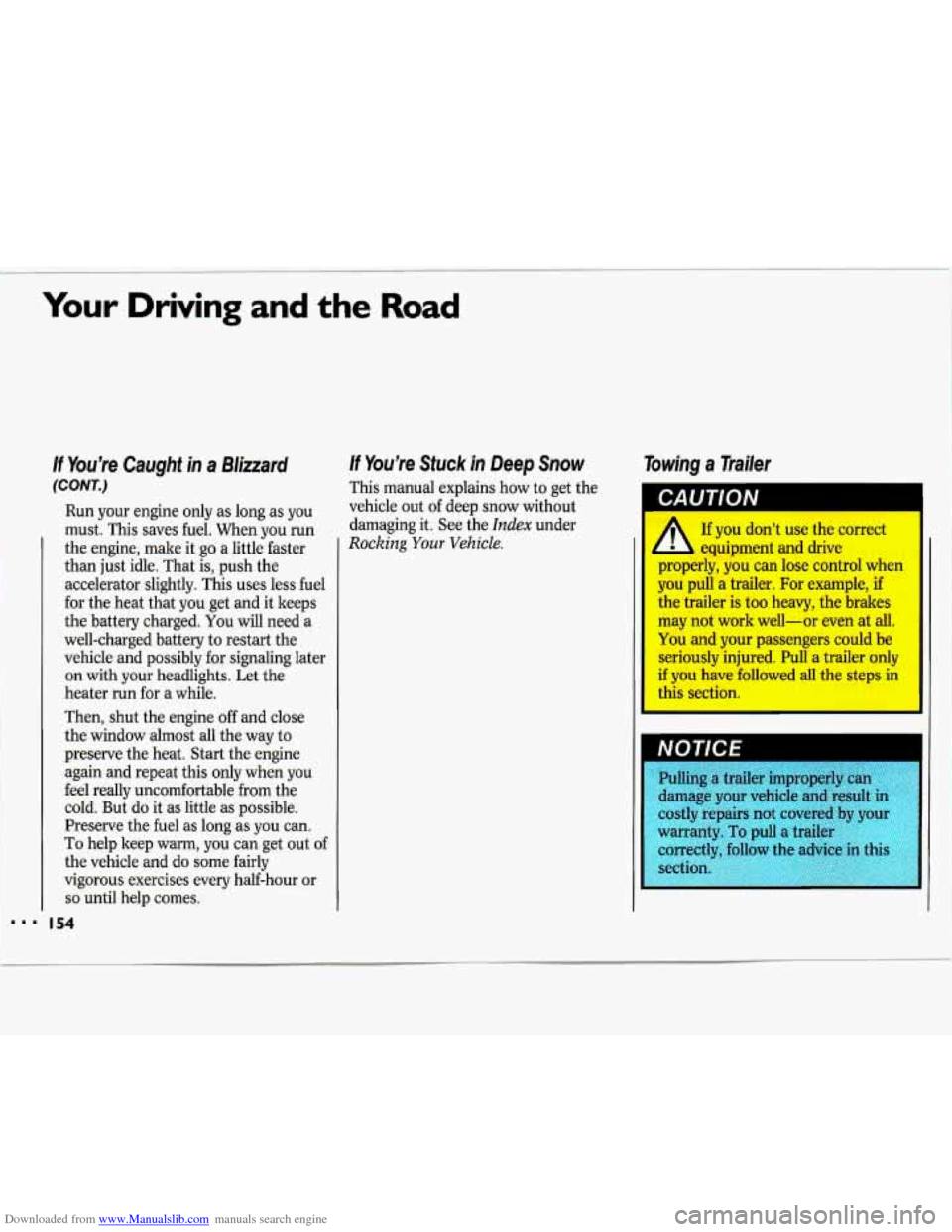
Downloaded from www.Manualslib.com manuals search engine Your Driving and the Road
I
If You’re Caught in a Blizzard
(CONT.)
Run your engine only as long as you
must. This saves fuel. When you run
the engine, make it go a little faster
than just idle. That is, push the
accelerator slightly. This uses less fuel
for the heat that you get and it keeps
the battery charged.
You will need a
well-charged battery to restart the
vehicle and possibly for signaling later
on with your headlights. Let the
heater run for a while.
Then, shut the engine
off and close
the window almost all the way to
preserve the heat. Start the engine
again and repeat this only when you
feel really uncomfortable from the
cold. But do it as little as possible.
Preserve the fuel as long as you can.
To help keep warm, you can get out of
the vehicle and do some fairly
vigorous exercises every half-hour or
so until help comes.
I54
If You’re Stuck in Deep Snow
This manual explains how to get the
vehicle out of deep snow without
damaging it. See the
Index under
Rocking Your Vehicle.
Towing a Trailer
II
CAUTION I
L
p.,gerly, you can lose control when
you pull a trailer. For example, if
the trailer is too heavy, the brakes
may not work well-or even at
all.
You and your passengers could be
seriously injured. Pull a trailer only
if you have followed all the steps in
this section.
L
railer improperly car
amage your vehicle and result in
costly repairs not covered by your
--
warranty. To pull a trailer
correctly, follow the advice
in this
__